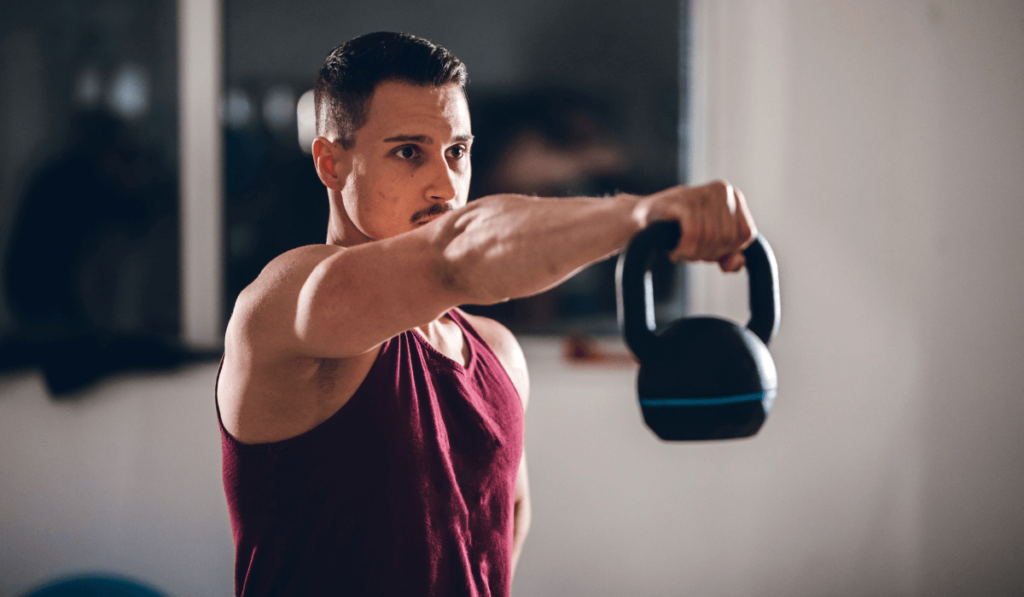The shoulder is the most complex joint in the human body. As well as the largest range of motion of any joint, it’s a very complex anatomical structure. Getting shoulder training wrong is particularly troublesome because of this complexity and the range of movement.
In this article I’m going to do a basic explanation of shoulder anatomy, we’ll look at movement patterns, different exercise approaches and how to train the shoulder effectively.
I’ll also provide you with an example kettlebell shoulder workout for you to get started with.
Jump to:
- Shoulder training – an overview
- Shoulder anatomy
- Shoulder training – the exercises
- External kettlebell shoulder rotations: 3 x 15 reps (warm up)
- Kettlebell lat raise: 3 x 15 reps
- Kettlebell shoulder press: 4 x 10-12 reps
- Kettlebell high pull: 4 x 8 reps (per side)
- Kettlebell power clean: 4 x 8 reps (per side)
- Kettlebell snatch: 4 x 10 reps (per side)
- Kettlebell gorilla row: 4 x 10 reps (per side)
- Bottoms up kettlebell shoulder press: 3 x 12 reps (per side)
- Overhead kettlebell walking hold: 3 x 60 second walking holds
- Kettlebell Shrugs: 4 x 12 reps
- American Kettlebell Swings: 4 x 20 reps
- How often should you train your shoulders?
Shoulder training – an overview
If I asked you to name shoulder exercises I’d bet a big chunk you’d mention the usual suspects… shoulder press, front raise, lat raise, dips. You might throw in bench presses and cable flys too. You wouldn’t be wrong by the way – they train shoulders.
The problem is they’re all pushing exercises, and that causes a problem.
Movement patterns for shoulder training
When we don’t balance our movement patterns, we create muscle imbalances. This leads to potential shoulder, neck and upper back pain.
The shoulder muscles don’t work as effectively. You can create impingements at the shoulder joint, which causes pain upon movement. This restricts your ability to train effectively, reducing the range of upper body exercise you can do.
These are the main movement patterns for shoulder training, and an example exercise for each one…
- Adduction: Lat raises (these adduct and abduct the shoulder)
- Abduction: Lat raises (these adduct and abduct the shoulder)
- Flexion: American kettlebell swings
- Extension: Dips
- Internal rotation: Light kettlebell internal rotations
- External rotation: Light kettlebell external rotations
- Elevation: Kettlebell shrugs
- 360° circumduction in the sagittal plane: Windmills
A thorough kettlebell shoulder workout should include a version of all of these movement patterns. By including them all, you’ll strengthen the rotator cuff muscles, improve general shoulder strength and protect the shoulder girdle from injury.
Shoulder pushing exercises
Most people will complete basic kettlebell shoulder workouts with pushing movements. These bias the anterior and medial deltoid (front and middle of the shoulder). Examples of these exercises with kettlebells include…
- Kettlebell shoulder press
- Kettlebell bench press
- Kettlebell push press
They tend to be strong shoulder exercises, where you’ll lift the big weights. They also have core strength benefits, because supporting a kettlebell overhead needs a tight core as well as shoulder stability.
Shoulder pulling exercises
There are a wide range of dynamic shoulder exercises that require pulling. Some of the best kettlebell shoulder exercises start with a pull. It’s another strong shoulder exercise group because they are often explosive movements requiring a lot of upper body movement. Examples include…
- Kettlebell Sumo Deadlift High Pull
- Kettlebell alternating high pull
- Kettlebell shrugs
These movements will bias the rear delts and upper back, including the traps. They require a lot of movement and stability at the shoulder blade. They also make for a more complete upper body workout.
Shoulder anatomy
You’re not reading this for an in-depth review of what the shoulder is and how it works, but I need to explain a few basic points. If I don’t, you won’t grasp why the program I’ve suggested looks like it does!
The shoulder is a complex network of bones, muscles, tendons, ligaments, nerves, and blood vessels. It consists of four separate bones and 8 separate muscles, but there are 18 other muscles that have an indirect impact on the joint. They do this by attaching to the bones in the shoulder joint.
The range of motion in the shoulder is huge. If you fancy geeking out about shoulder movement, take a look at this video…
Consequences of poor shoulder training
If you get your shoulder training wrong, you’ll seriously compromise shoulder health. I’ve already mentioned muscle imbalances and impingements as common shoulder complaints, but there’s more than that.
In 2010 an analysis of the scientific literature around shoulder problems was performed by a team of researchers. They concluded that…
‘The results of the review indicated that up to 36% of documented resistance training related injuries and disorders occur at the shoulder complex. Trends that increased the likelihood of injury were identified and inclusive of intrinsic risk factors such as joint and muscle imbalances…’
This research shows just how vulnerable the shoulder is to poor training methods. In order to ensure shoulder health, we need to be training properly. The kettlebell shoulder workout in this article balances all of the necessary movements.
Shoulder training – the exercises

This is a kettlebell shoulder workout that covers all of the bases you need to. It’s a mixture of dynamic exercises, explosive exercises, stability exercises and functional movement.
Across these 11 kettlebell exercises we’ve addressed all of the necessary elements of good shoulder training. All of the exercises are scalable for beginners to advanced lifters. There’s also plenty of variety in there to make sure you don’t get bored.
The exercise won’t just give you stronger shoulders, they’ll also help you in the following ways…
- Improve the health and function of the rotator cuff muscles
- Make a weight more stable when held in an overhead position
- Improve your shoulder mobility
- Give you more stable shoulders for explosive movements such as throwing
- Help you with shoulder rehab post injury
- Aid in shoulder movement – especially if they’ve previously been impinged
- Help your shoulder sit in a more balanced position, making regular shoulder exercises safer
- Provide you with more rotator cuff stability, which will prevent rotator cuff issues
A good shoulder workout doesn’t just focus on building bigger shoulder muscles. It should care about shoulder health, and strengthen the muscles around the joint that impact it. We need to think about the kind of kettlebell exercises we select in order to ensure this.
You can’t just throw together a bunch of regular shoulder exercises and think that’ll be sufficient to take care of all shoulder rehab and shoulder strength needs. If anything, a haphazard approach is likely to do more harm than good!
Pay attention to the set and rep ranges of the exercises below…
External kettlebell shoulder rotations: 3 x 15 reps (warm up)
Use a light weight here – we want to focus on movement quality. It activates the posterior delt and improves blood flow to the shoulders ahead of the other work. Always do this one first because it helps to activate the shoulder muscles.
Kettlebell lat raise: 3 x 15 reps
This is like an extended warm up. It’s a legit shoulder exercise in its own right, with low injury risk and high pay off. Simply lift kettlebells to shoulder height under control, then return to the sides. Repeat as needed. Keep your spine in a neutral position throughout.
Kettlebell shoulder press: 4 x 10-12 reps
The kettlebell shoulder press is NOT a push press, so keep your feet flat here. Keep your core tight as you press the kettlebells in an overhead motion from a standing position. It can also be done from a half kneeling position or a seated position, but I prefer standing.
Kettlebell high pull: 4 x 8 reps (per side)
This is one of the more ballistic and explosive movements in the program. It trains the upper back muscles as well as the shoulders. Pull the kettlebell from the floor to chest level in a smooth but explosive motion.
Kettlebell power clean: 4 x 8 reps (per side)
The kettlebell clean is another explosive kettlebell movement. To make it effective, power the kettlebell up and make sure there’s an elbow under shoulder position at the end. This is the rack position and it takes a lot of pressure off the shoulder, despite a kettlebell being held at shoulder level.
Kettlebell snatch: 4 x 10 reps (per side)
This exercise is another one of the explosive movements. All kettlebell workouts should contain these kinds of movements. Take the kettlebell from the floor to a tall position in one go, using the shoulder muscles to stabilize the kettlebell overhead.
Kettlebell gorilla row: 4 x 10 reps (per side)
This is usually used as a back exercise, but the back is an important part of shoulder alignment and stability. It also engages the muscles that control the shoulder blade. The Gorilla row trains the rear delt, which is another reason why it has earned its place here.
Bottoms up kettlebell shoulder press: 3 x 12 reps (per side)
You may be wondering why this exercise is in here, given we’re already doing a shoulder press. It’s because of the focus and time under tension. We need to use a moderate weight and concentrate for the entire movement. There’s less stability and an extra challenge with the kettlebell being in a bottoms up position.
Overhead kettlebell walking hold: 3 x 60 second walking holds
These exercises are only done when we’re far enough into the workout that there’s a lot of blood flow to the shoulders, because the shoulders have a stability element to them.
Kettlebell Shrugs: 4 x 12 reps
This is an exercise where you can go heavy. It’s another posterior delt, upper trap and core engagement exercise. Keep your feet shoulder width apart and shrug the weights up. A coaching tip is to bring the shoulders to the ears, but squeeze the shoulder blades together as you do.
American Kettlebell Swings: 4 x 20 reps
The kettlebell purists don’t like this exercise, thinking it’s an inferior version of the original kettlebell swing, but I love it. It trains the entire body, but at the top of the rep you really work the shoulders hard. It’s a full body dynamic exercise, it’s a core exercise and at a high rep range has great shoulder benefits.
How often should you train your shoulders?

This is answered by a couple of further questions…
1. How much do you need to train your shoulders?
2. How well are you recovering?
Let me explain…
If you have a rehab concern, you should be guided by your physical therapist. Depending on the nature and severity of your problem, this could be anywhere between daily or weekly training sessions.
If you’re doing it for athletic purposes, it could be 3-4 times per week, depending on the outcome measures. Keep assessing progress – if you’re making progress, keep it at the same rate. If you’re making no progress, increase the volume and intensity of your training.If you’re regressing, I’d cut it back – you might be overtraining.
For vanity, the same rules apply.
A governing element of shoulder training is how well you are recovering. Tired muscles are more vulnerable to injury, so if you’re not able to perform as well as you previously did, reduce your training volume and intensity.
Listen to your body. If it’s tired and underperforming, let it rest.
Post kettlebell shoulder workout tips
Once you’ve done the work, then what? How do you help to make sure your shoulders stay healthy? How do you help them to recover ahead of the next workout?
I like to eat plenty of protein, drink lots of water, sleep well and finally… I stretch!
Shoulder stretches
Here’s the stretches I like to help keep my shoulders healthy...
The passive hang
I hold this one for 30 seconds each across 3-4 sets. Sometimes I’ll do more if my shoulders and lats are feeling tight.
Prone chest stretch
This one is a simple stretch that helps both the chest and shoulders. You can’t really stretch the chest without including the anterior deltoid (front of the shoulder). It’s an important stretch because most of us have tight chests from laptop use, driving, eating etc with a poor posture.
Follow this kettlebell shoulder workout, end with these stretches and you’ll be good to go! You’ll build yourself a pair of badass shoulders that are strong, look great, are resistant to injury and will help you become a better athlete!















